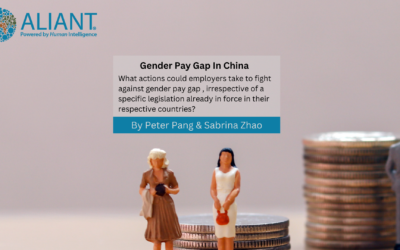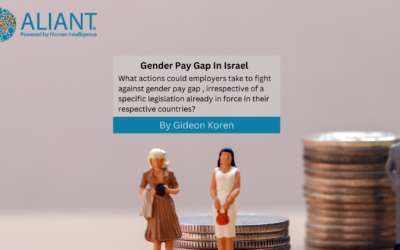WHAT ACTIONS COULD EMPLOYERS IN ITALY TAKE TO FIGHT AGAINST GENDER PAY GAP, IRRESPECTIVE OF A SPECIFIC ITALIAN LEGISLATION ALREADY IN FORCE ?
According to official statistics data, the gender pay gap in Italy is theoretically about 5%, but in reality it is much wider if we consider the variable part of salary (estimated at 25% in the private sector and 17% in the public sector). A gap that progressively rises as the career path progresses (up to 43% at the highest levels).
Women do not only usually have lower employment rates than men, they also earn less. The existence and extent of the gender pay gap depends on a combination of different cultural and economic reasons, such as the inequalities that women face in the access to work and career progression, the consequences of career breaks or leaves or part-time work due to caring responsibilities, stereotypes about the roles that men and women can cover.
Over the past few years, the gender pay gap has been slowly narrowing but remains substantial in almost all jurisdictions.
At EU Level
At EU level, a new legislation on pay-transparency measures is in the course of being approved and will require (larger, for now) companies to disclose information on pay by category of work. As a result, it will make it easier for employees to compare salaries and to show existing gender pay gaps; employers that do not comply with the new rules shall be subject to fines and shall be obliged to take positive actions when their gender gap is over 5%.
In Italy
Meanwhile, in Italy, Law no. 162/2021 on “equal opportunities for men and women in employment” (herein after “Law 162/2021”) came into effect on December 2021 providing for specific measures helping to reduce gender pay gap.
The Gender Equality Certification
One of the most interesting news promoted by Law 162/2021 is the introduction of a “Gender Equality Certification”.
Namely, “as of January 1, 2022, gender equality certifications shall be implemented in order to certify the concrete policies and measures taken by employers to reduce the gender gap in relation to growth opportunities in the company, equal pay for equal tasks, gender gap management policies, and maternity protection”.
Obtaining such certification is not currently mandatory; to induce private companies to comply, those in possession of a gender equality certification:
50 i) will be able to have an exemption from the payment of employer social security contributions (with a cap at 1% or 50.000 euros per year for each company); and
50 ii) shall be granted a reward score in the evaluation of applications for financing projects and calls for tenders by authorities holding European, national and regional funds
The Gender Report on the situation of male and female personnel
It is important to mention that Law 162/2021 reduces from 100 to 50 the number of employees of public or private companies required to produce a “Gender Report”. Specifically, these companies must prepare at least every two years a report on the situation of male and female employees in each of the professions and in relation to the status of recruitment, training, professional promotion, the intervention of the Wage Guarantee Fund, dismissals, retirements, and the actual remuneration paid.
As for companies with up to 50 employees, instead, the Gender Report is not mandatory but can be produced on a voluntary basis.
With specific reference to procedures related to public contracts financed, in whole or in part, with the resources provided by the European recovery fund (i.e. “Next generation EU” fund), again in 2021, it has been provided that companies intending to participate in a tender relating to such public contracts must provide a Gender Report certifying the employer’s respect of equal opportunities. Failure to submit the Gender Report will result in penalty of exclusion from the tender or the offer. Also, as a necessary requisite for participation, companies have to ensure that at least 30% of the recruitment for the execution of the contract are women and young people, while additional points are awarded to the tenderer or candidate who, among other things, provides for the recruitment of young people and women beyond the mandatory 30% quota.
Gender balance in the composition of Boards of Directors
Also, Law 162/2021 extends the criterion of “Gender Balance in the composition of Boards of Directors”, already provided for listed companies, to unlisted companies controlled by public administrations, established in Italy.
Namely, the entities’ bylaws must provide that the allocation of directors to be appointed shall be made to ensure gender balance: the least represented gender must obtain at least two-fifths of the directors appointed.
As already pointed out, Gender Pay Gap is the result of a combination of social and economic factors which reduce women’s earning capacity over their lifetimes. Consequently, laws ensuring equal pay only are not sufficient to reduce such gap. It is required a real cultural change to remove barriers to women’s full and equal participation in the workforce.
Translated into practical actions, such as:
- developing up-to-date legislation on the subject;
- implementing family-work balance policies (e.g., parental leave, maternity and paternity leave, smart working, part-time) that protect women, especially at senior level, from the disadvantages generated by having to bear most of the family care responsibilities;
- raising awareness toward overcoming cultural prejudices;
- increasing pay transparency and correcting pay inequalities within organizations.
Why should employers wait for the implementation of a specific legislation fighting against gender pay gap applicable to any entity and at any level? Irrespective of a specific legal requirement:
(i) smaller companies can take example from legal provisions already in force for larger companies or from companies’ best practices in place, also in other jurisdictions;
(ii) employers should embrace such rules and best practices which represent an excellent opportunity to monitor the state of health of the organization they are managing.
Please follow these six part series and find out in Part II what actions could employers in Lithuania take to fight against gender pay gap.






